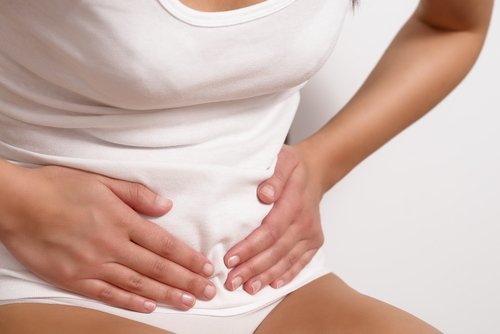Tips to Help Reduce Your Menstrual Pain

When that time of the month comes around, certain discomfort can be unavoidable. In general, when pain intensity ranges from light to moderate, you can reduce your menstrual pain through certain simple actions.
It’s normal for this discomfort to keep us from being able to carry out certain activities with the same energy as always. However, that doesn’t mean we should do nothing until we feel better.
On the contrary, participating in certain activities is advisable. Of course, the key is to keep a stable and unhurried pace.
Why do we experience pain during menstruation?
Menstruation produces pain in our lower abdomen, back, breasts and head. In some cases, this pain can spread to other parts of the body as well, such as our legs. To sum it up, the general discomfort that results from menstrual pain can be quite uncomfortable.

So, why do we experience pain during menstruation? Our periods hurt because, each month, our bodies eliminate the tissue of unfertilized eggs. In the process, a series of hormonal changes take place that can include uterine contractions.
One of the hormones that our body secretes the most during our periods is prostaglandin. This hormone helps to facilitate the expulsion of said tissue, but it also causes women to experience pain because it produces uterine contractions.
Pain occurs because of uterine contractions, in response to the secretion of prostaglandin and arachidonic acid, which produces menstrual bleeding.
There are two categories that define menstrual pain, according to its duration and intensity: primary or secondary dysmenorrhea. A gynecologist can determine which is the case based on a physical evaluation.
Tips to help reduce your menstrual pain
As long as the pain isn’t keeping your from performing activities, there are certain actions you can take to help reduce your menstrual pain.
In general, it’s a question of small measures that help bring relief, if practiced regularly and patiently.
1. Walking or low-impact exercises
It’s true that our periods often invite us to slow down and avoid certain activities. However, if pain is present, then going for a brisk walk – about 20 or 30 minutes – is a great idea. This helps reduce the intensity of uterine contractions, providing mid- to long-term relief.
In the same way, you can combine walking with low-impact exercises. For example, you can try yoga or certain pilates exercises.

2. Raise your legs
While it may surprise you, elevating your legs for periods of 10 minutes can greatly contribute to period pain relief. This is because raising your legs improves your blood flow, which causes pain to cease. It’s best to elevate your legs for a little bit, take a rest, and then do it again.
3. Heating pad
Heat can help your contracted muscles to relax, little by little, and to improve your circulation. Therefore, using heating pads or warm compresses can help reduce your menstrual pain. In other words, heat has a vasodilator effect.
It’s worth pointing out that combining the application of heat along with relaxing massage in the abdomen area will also provide excellent pain relief.
Massages should consists of slow, circular movements, barely applying pressure to the area. These movements should be constant for 10 to 15 minutes in order to produce true relief. And if you decide to take a warm shower or bath instead of applying a heating pad, you’ll get the same effect.
4. A hot drink
Another way to take advantage of the effects of heat involves having a hot drink. In general, it’s best to opt for natural infusions such as chamomile, cinnamon, ginger or mint.
All of these infusions are harmless and offer significant relief, as they help to release retained liquids. It’s best to drink them calmly, taking small sips.
Staying well-hydrated keeps liquids from accumulating, and this also contributes to reduced menstrual pain.
5. Choose your food well
Just like it’s best to drink slowly, it’s also important to be careful when it comes to what you eat. If you prepare large meals with hearty ingredients, digestion will be slower and more difficult. As a result, you may experience increased discomfort.
It’s best to spread out smaller and lighter meals throughout the day. Choose foods that offer energy and won’t cause you to feel weighed down.
At the same time, even though it’s normal to experience sweet cravings, you should limit your sugar intake. Keep in mind that overdoing it will only increase your menstrual pain.

6. Avoid stimulants
Caffeine and theine are substances that increase our catecholamine (stress hormone) levels. In turn, they also contribute significantly to menstrual pain. Therefore, it’s good to keep your intake of these stimulants to a minimum – or avoid them altogether.
When to see a doctor
If after taking all the measure you have within your reach and you still can’t reduce your menstrual pain, then it’s important you see a doctor. Remember that diagnosis and proper treatment will help you avoid a lot of issues in the long term.
At the same time, if you experience pain in the lower abdomen in different moments apart from menstruation, as well as other symptoms, this can be a sign that something else is going on with your body.
When that time of the month comes around, certain discomfort can be unavoidable. In general, when pain intensity ranges from light to moderate, you can reduce your menstrual pain through certain simple actions.
It’s normal for this discomfort to keep us from being able to carry out certain activities with the same energy as always. However, that doesn’t mean we should do nothing until we feel better.
On the contrary, participating in certain activities is advisable. Of course, the key is to keep a stable and unhurried pace.
Why do we experience pain during menstruation?
Menstruation produces pain in our lower abdomen, back, breasts and head. In some cases, this pain can spread to other parts of the body as well, such as our legs. To sum it up, the general discomfort that results from menstrual pain can be quite uncomfortable.

So, why do we experience pain during menstruation? Our periods hurt because, each month, our bodies eliminate the tissue of unfertilized eggs. In the process, a series of hormonal changes take place that can include uterine contractions.
One of the hormones that our body secretes the most during our periods is prostaglandin. This hormone helps to facilitate the expulsion of said tissue, but it also causes women to experience pain because it produces uterine contractions.
Pain occurs because of uterine contractions, in response to the secretion of prostaglandin and arachidonic acid, which produces menstrual bleeding.
There are two categories that define menstrual pain, according to its duration and intensity: primary or secondary dysmenorrhea. A gynecologist can determine which is the case based on a physical evaluation.
Tips to help reduce your menstrual pain
As long as the pain isn’t keeping your from performing activities, there are certain actions you can take to help reduce your menstrual pain.
In general, it’s a question of small measures that help bring relief, if practiced regularly and patiently.
1. Walking or low-impact exercises
It’s true that our periods often invite us to slow down and avoid certain activities. However, if pain is present, then going for a brisk walk – about 20 or 30 minutes – is a great idea. This helps reduce the intensity of uterine contractions, providing mid- to long-term relief.
In the same way, you can combine walking with low-impact exercises. For example, you can try yoga or certain pilates exercises.

2. Raise your legs
While it may surprise you, elevating your legs for periods of 10 minutes can greatly contribute to period pain relief. This is because raising your legs improves your blood flow, which causes pain to cease. It’s best to elevate your legs for a little bit, take a rest, and then do it again.
3. Heating pad
Heat can help your contracted muscles to relax, little by little, and to improve your circulation. Therefore, using heating pads or warm compresses can help reduce your menstrual pain. In other words, heat has a vasodilator effect.
It’s worth pointing out that combining the application of heat along with relaxing massage in the abdomen area will also provide excellent pain relief.
Massages should consists of slow, circular movements, barely applying pressure to the area. These movements should be constant for 10 to 15 minutes in order to produce true relief. And if you decide to take a warm shower or bath instead of applying a heating pad, you’ll get the same effect.
4. A hot drink
Another way to take advantage of the effects of heat involves having a hot drink. In general, it’s best to opt for natural infusions such as chamomile, cinnamon, ginger or mint.
All of these infusions are harmless and offer significant relief, as they help to release retained liquids. It’s best to drink them calmly, taking small sips.
Staying well-hydrated keeps liquids from accumulating, and this also contributes to reduced menstrual pain.
5. Choose your food well
Just like it’s best to drink slowly, it’s also important to be careful when it comes to what you eat. If you prepare large meals with hearty ingredients, digestion will be slower and more difficult. As a result, you may experience increased discomfort.
It’s best to spread out smaller and lighter meals throughout the day. Choose foods that offer energy and won’t cause you to feel weighed down.
At the same time, even though it’s normal to experience sweet cravings, you should limit your sugar intake. Keep in mind that overdoing it will only increase your menstrual pain.

6. Avoid stimulants
Caffeine and theine are substances that increase our catecholamine (stress hormone) levels. In turn, they also contribute significantly to menstrual pain. Therefore, it’s good to keep your intake of these stimulants to a minimum – or avoid them altogether.
When to see a doctor
If after taking all the measure you have within your reach and you still can’t reduce your menstrual pain, then it’s important you see a doctor. Remember that diagnosis and proper treatment will help you avoid a lot of issues in the long term.
At the same time, if you experience pain in the lower abdomen in different moments apart from menstruation, as well as other symptoms, this can be a sign that something else is going on with your body.
All cited sources were thoroughly reviewed by our team to ensure their quality, reliability, currency, and validity. The bibliography of this article was considered reliable and of academic or scientific accuracy.
- La mujer, el ciclo menstrual y la actividad física. Rev. Arch Med Camagüey Vol 21 (2) 2017. http://scielo.sld.cu/pdf/amc/v21n2/amc150217.pdf
This text is provided for informational purposes only and does not replace consultation with a professional. If in doubt, consult your specialist.








